How to Plant and Grow Peony
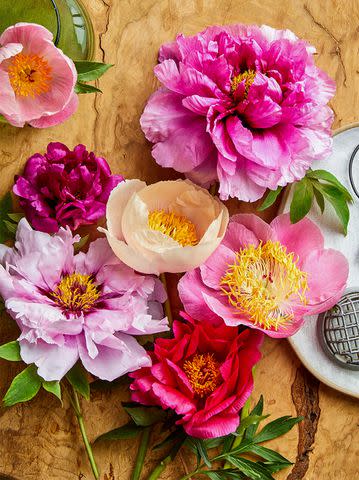
Peony is a classic garden perennial with many gorgeous colors and forms. With proper care, its lovely blooms will return to your landscape each spring.
Reviewed by Sylvia DuaxReviewed by Sylvia Duax
With its vibrant hues, sweet scent, and layers of large petals, peony makes a beautiful addition to any bouquet or garden. Known for its fluffy spring flowers, the tough perennial returns year after year—for upwards of 100 years, if well cared for. In addition to its showy blooms, the plant has leathery deep green foliage that's attractive in its own right and withstands weather extremes. There are many types of peonies, each with unique growth habits, flower shapes, and colors. Although pink is a fan favorite, peony flowers bloom in white, red, magenta, yellow, and coral.
Peony may look delicate, but the garden favorite is quite rugged and easy to grow with proper care and conditions. The perennial is hardy in USDA Zones 3-8, which includes most of the United States, so just about anyone can grow thriving peony plants in their garden.

Related: Experts Are Calling This Timeless Pink Bloom the 2024 Flower of the Year
Where to Plant Peony
Spring-blooming peonies are wonderful specimen plants. They can also be massed in the back of low borders or planted in a single row for a showstopping hedge.
Plant your peony in well-draining soil and full sun where it will receive at least six hours of direct sunlight daily. Make sure the spot you choose allows the plant to have undisturbed roots. Shelter it from the wind, but avoid planting it close to other trees or shrubs to prevent the plants from competing for resources.
How and When to Plant Peony
Peonies are sold as bare-root tubers or as divisions of a young plant. Either starter should be planted in the fall, a few weeks before the first frost. If you need to move an established plant, fall is the best time to do so as well. If you must plant in spring, check that the ground is workable and there's no risk of frost. Spring-planted peony plants usually lag a year behind fall-planted peonies.
To plant a division from a nursery, dig a hole twice as wide and the same depth as the container. Set the plant in the hole at the same depth as it sat in the container. A sure way for a peony to lack blooms is to plant it too deeply. When planting multiple peonies, space them 3 to 4 feet apart to allow plenty of room to grow. Water the garden bed after planting.
Bare-root tubers shouldn't be placed more than 2 inches below the soil level—they'll still send out shoots but won't flower when buried too deep. Dig a shallow hole and position the bare-root tuber. Cover it with soil, pressing down to remove air pockets, then water.
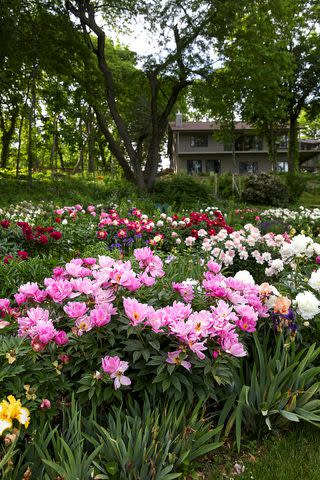
Related: This Midwestern Peony Garden Is Filled with Thousands of Blossoms
Peony Care Tips
As long as a peony's basic needs are met, the plant will live for many years.
Light
Peony plants thrive in full sun but will tolerate partial shade. Full sun ensures the perennial has lush blooms and healthy foliage.
Soil and Water
Peony does best in well-drained soil and benefits from a compost amendment if the soil is too heavy. The plant dislikes having its roots disturbed and can protest by withholding blooms.
Water peony at the base of the plant at ground level rather than watering from above onto the foliage—this will prevent disease. Give plants enough water to soak into the top 5 inches of soil. Continue to water your plants even after the flowers have faded so the leaves remain healthy.
Related: How to Improve Soil in an Established Plant Bed
Temperature and Humidity
Peony is a cold hardy plant; many species can tolerate winter temperatures as low as -40°F, which makes them an excellent choice for cold areas. Herbaceous peonies need a winter dormancy period of about six weeks during which the temperature is consistently around 40°F, so they aren't often grown in hot areas. The perennial grows best in average humidity.
Fertilizer
To fertilize your peony plants, apply compost, bone meal, or well-rotted manure in early summer as a soil amendment. You can also use a fertilizer with higher levels of phosphorus (P) and potassium (K), following the directions on the product label. Avoid nitrogen-heavy (N) fertilizers. These promote good foliage growth but discourage strong blooms.
Related: Why Are Nitrogen, Phosphorus, and Potassium in Plant Fertilizer?
Pruning
After your peony plants have put on their show for the year, a little TLC will ensure they return even stronger next year. Deadheading, or removing faded flowers, helps the plant save energy for the following year's blooms and prevents fungal diseases. Remove the spent blooms, but don't cut away any foliage—the plant will need those leaves to help build up flowers the next year.
Herbaceous peony plants can be cut to the ground after fall frost has killed off the foliage. In the spring, new growth will appear from the roots. Tree peonies should be pruned in late spring. Remove any damaged wood, and make your cuts at an angle directly above outward-facing buds.
Pests and Problems
You may see lots of ants on peonies. Don't fret; they won't harm your plant. Just ignore them, and they'll eventually leave to feed elsewhere. You should inspect your plants for signs of common peony diseases, though. Here are a few to watch out for:
Botrytis blight: This disease plagues peony plants in damp seasons when leaves get too wet and develop dark gray mold.
Powdery mildew: Mildew shows up as a white powder. It's unattractive more than it is harmful to your plant.
Peony blotch: This disease is also known as red spot or measles because of the color of the lesions. It won't kill your plant, but it does disfigure it.
Peony wilt: Almost always a fatal affliction, peony wilt is a fungal infection in the soil that destroys the leaves and stems.
How to Propagate Peony
The easiest way for home gardeners to propagate herbaceous peony plants (the most common type in the United States) is by division, but it is also possible to grow them from seed.
Related: How to Divide Perennials and Expand Your Garden for Free
How to Propagate by Division
Dig up the entire plant with a shovel after the foliage has faded in the fall. Remove as much of the soil from the roots as possible. Cut off sections of the crown with a sharp knife, making sure each section has roots and at least three buds. Replant the sections immediately in a prepared garden bed and water them well.
Division doesn't work with tree peonies; gardeners usually sow seed for them.
How to Propagate by Seed
Most peony plants produce seeds that can be harvested and sown, but peonies grown from seed often don't resemble the parent plant. Fresh seed harvested immediately after the plant blooms results in the best plants the soonest. Purchased dry seed should be sown in summer. It requires longer to hydrate and break its dormancy period.
Prepare a garden bed that will be home to the young peony plants for the first three years. Press peony seeds into the soil no more than 1/2 inch deep and 1 to 2 inches apart. Don't cover the seeds with soil. Water the bed and apply 1 inch of wood chips or wood mulch. Cover the entire bed with a sheet of clear plastic, weighted down on the edges, and leave it in place until the following early spring when the seedlings start to grow.
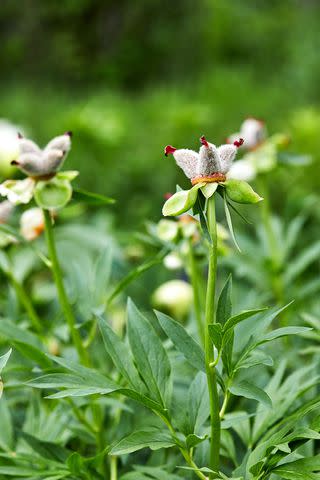
Types of Peony
There are three main types of peony: herbaceous, tree, and itoh.
Related: 25 Best Peonies to Grow for Their Beautiful Blooms
Herbaceous Peonies
Herbaceous peonies (Paeonia lactiflora) are the most common in gardens, with hundreds of varieties to choose from. These plants usually have scented flowers in shades of pink, red, and white. As the name suggests, herbaceous peonies don't form woody stems. Instead, the stems stay green and flexible, so they may need staking to keep from flopping over, especially when the flowers get wet in the rain. These peonies produce new growth from the plant's crown in spring, which dies back to the ground after a frost, similar to most other perennials. Herbaceous peony plants grow 2 to 3 feet tall.
Tree Peonies
As the name suggests, tree peonies (Paeonia suffruticosa or Paeonia x lemoinei, also called deciduous peonies) grow from a trunk-like base. They are more expensive and grow slower but can eventually reach up to 5 feet tall. Tree peonies don't need staking because their woody stems can withstand the weight of their huge flowers. 'Seidai' is a tree peony variety that produces double-flower pink blooms that can reach a mesmerizing 8 inches in diameter.
Itoh Peonies
The itoh peony, or intersectional peony (Paeonia x lemoinei x Paeonia lactiflora), is a hybrid of the herbaceous and tree types. These peonies offer more unusual colors, including orange and yellow. Some popular varieties are 'Bartzella' and 'Cora Louise'. All itoh cultivars grow to a middle height between the garden and tree types, usually about 3 feet tall.
There is no shortage of colorful peony varieties within each type—here are just a few favorites.
'Blaze' Peony
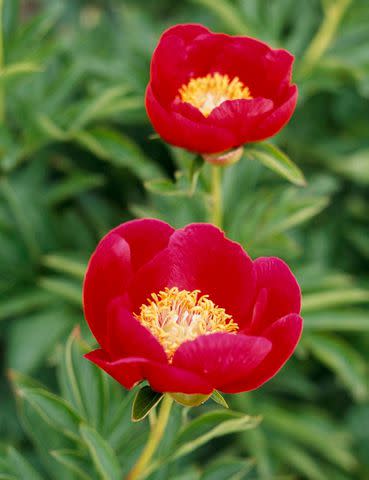
Released in 1973, Paeonia 'Blaze' offers single, 6-inch scarlet blooms early in the season. It grows 26 inches tall in Zones 3-8.
'Bowl of Beauty' Peony
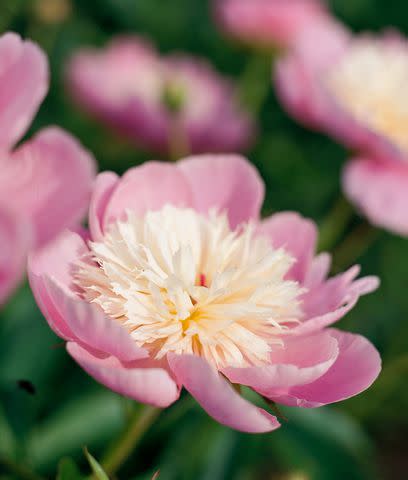
Introduced in 1949, Paeonia 'Bowl of Beauty' blooms midseason in Zones 3-8. It has 10-inch anemone-flowered (or Japanese form), deep sugar-pink cupped blooms. The center is crowded with narrow, creamy white petaloids.
'Festiva Maxima' Peony
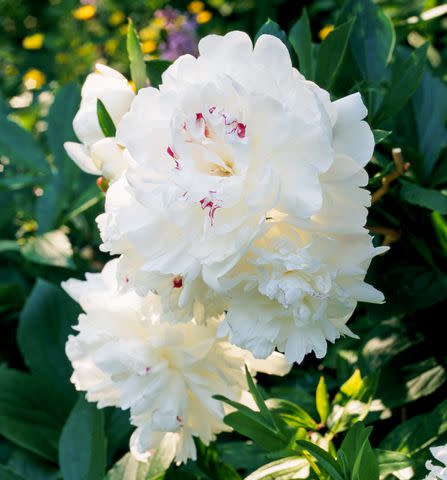
Paeonia 'Festiva Maxima' is an heirloom from the 1850s that's still popular. It bears white flowers with tiny flecks of crimson and grows 3 feet tall in Zones 3-7.
Fernleaf Peony
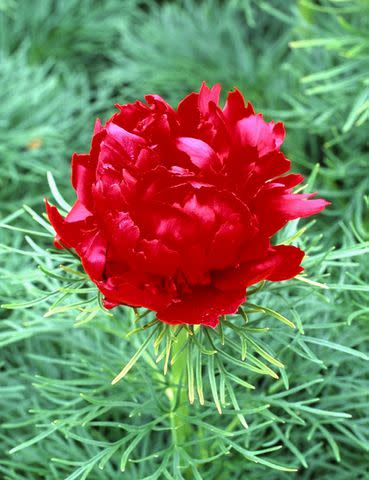
Paeonia tenuifolia has rich red 3-inch flowers in early to midspring in Zones 3-8. As its common name suggests, fernleaf peony has fernlike leaves with many fine-textured segments.
Peony Companion Plants
Baby's Breath
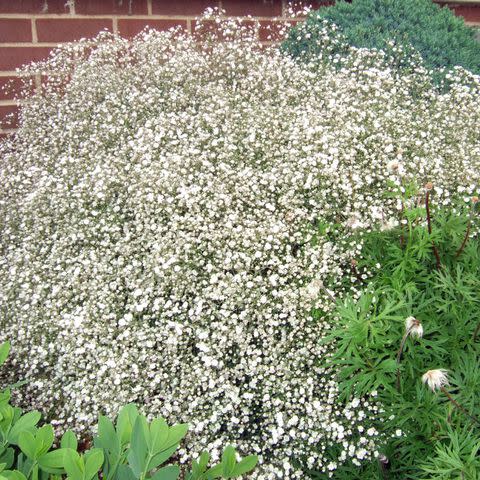
With its loose, billowy panicles of tiny single or double pink or white flowers, baby's breath provides a light, airy look. The creeping forms drape beautifully over rock walls. After bloom time, deadhead the plant for neatness. Baby's breath prefers sweet (alkaline) soils with full sun and excellent drainage.
Shasta Daisy
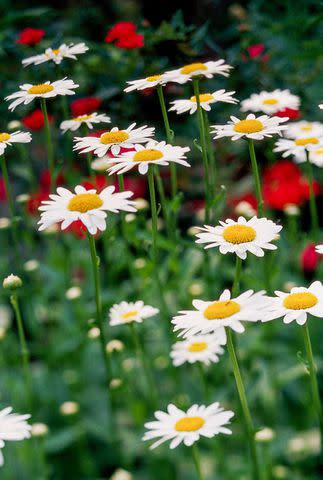
Easy, always fresh, and always eye-catching, Shasta daisy is a longtime favorite. All cultivars produce white daisy flowers in various degrees of doubleness and size. The sturdy stems and long vase life make the flowers unbeatable for cutting. Shasta daisy thrives in well-drained, not overly rich soil. Taller sorts may need staking.
Flax
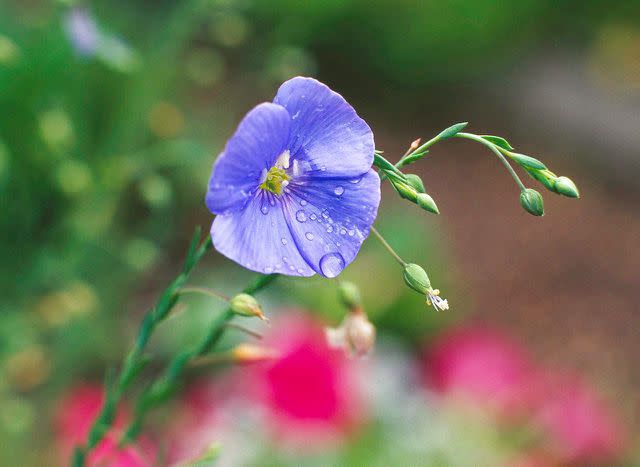
Looking at the delicate little flax plant, with its masses of open, silky flowers often in purest blue, it's hard to imagine that it produces tough linen fibers. Each bloom lasts only a day, but the plant stays in bloom for a while since it yields so many flowers—not only in blue but also clear yellow, depending on the variety. Flax must have light, free-draining soil; wet feet will kill it. Flax enjoys full sun but will tolerate light shade, especially in the southern portion of the United States.
Garden Plans for Peony
English-Style Front Yard Garden Plan

Give your home a welcoming feel with an exuberant cottage garden in the front yard. Cottage gardens generally feature a colorful assortment of plants in natural disarray, sometimes with clear pathways and sometimes without. This English-style front garden plan captures the essence of a cottage garden.
Deer-Resistant Garden Plan
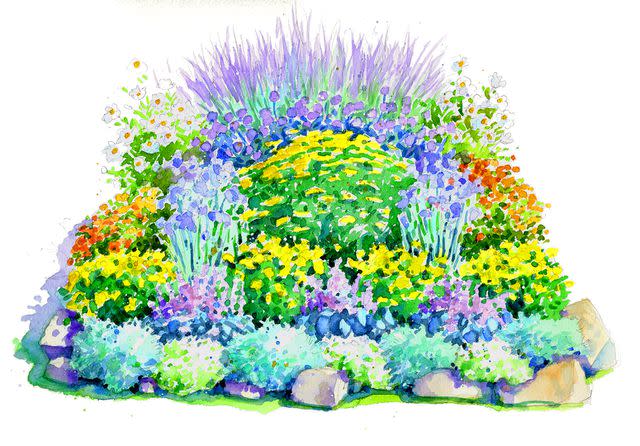
Deer may be beautiful creatures, but they also can wreak havoc in a garden. If you have a deer herd that sees your yard as a salad bar, you have to get creative to keep the hungry critters from snacking on your plants. Selecting deer-resistant varieties—including peony—that are lower on Bambi's menu is an effective strategy.
Frequently Asked Questions
Do wild animals eat peonies?
Keep your eyes open for rabbits and squirrels—they'll be happy to munch on your peony plants. Deer don't bother peonies, though, unless they are the only food available.
What pollinators are attracted to peony flowers?
Those gorgeous spring blooms attract butterflies, honeybees, and hummingbirds. Bees are less attracted to red peony flowers, so plant varieties that bloom with paler blossoms to support the bee population.
Can I prolong a peony plant's blooming period?
No, it isn't possible to prolong the blooming period of peonies, but there are ways to keep cut blooms longer including cutting the stems at an angle and putting them in the refrigerator overnight.
Should peonies be staked?
Staking peonies can be helpful, especially for types that have particularly large, heavy blooms. Consider using grow rings during the blooming period to help corral and support the flowers.
Related: 6 Fascinating Things You Should Know About Peony Flowers
For more Better Homes & Gardens news, make sure to sign up for our newsletter!
Read the original article on Better Homes & Gardens.
